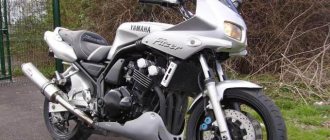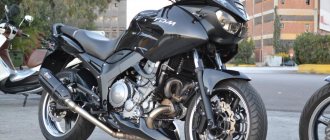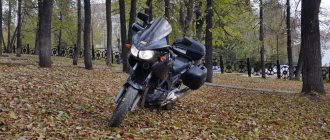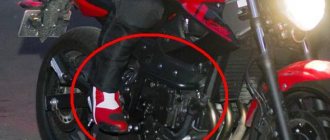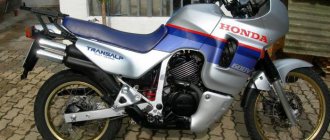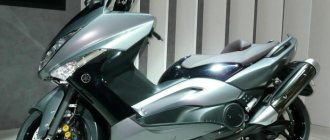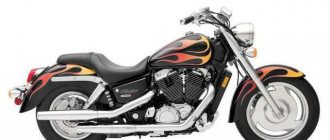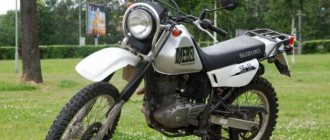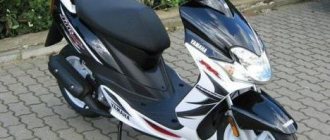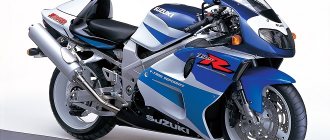This is a road bike that is perfect for urban conditions. There is nothing unusual about it; it is a fairly ordinary representative of the class. However, despite the fact that it finished production more than ten years ago, there are still many who want to purchase this model, because it has a low cost and a good resource.
The Yamaha FZS 600 Phaser is inferior in popularity to the FZ6. This motorcycle existed on the assembly line for quite a long time, despite the fact that it was mediocre, which in itself speaks of the quality and reliability of the model.
Specifications
The engine of this model was taken from the YZF 600 R Thundercat. It is for this reason that one can feel some sportiness and zeal in the character of the car. It may unpleasantly surprise you with a sudden start, but for some this is not a minus at all, but a plus. First of all, we are talking about people who have no need for a sports bike, but sometimes want to feel at least something of the sporty dynamics.
Model features
The new product from the Land of the Rising Sun, shown to the public, was an excellent combination of ergonomics and comfort of a classic bike with the handling and dynamics of a sports motorcycle, at a relatively low cost of the model.
The Phaser 600 had a duplex frame made of steel, on which a fairly powerful engine was installed, providing the machine with amazing dynamics.
The direct seating position of the driver ensured comfort during long journeys.
To complete the picture, it is necessary to mention the disc brake system and the almost racing geometry of the chassis, which especially attracted European fans of motorcycles for daily use, but with pronounced sporting ambitions.
Within a couple of years (1999), the Yamaha Fazer 600 was recognized as the best-selling bike in its class, which was confirmed very soon - by the end of 2002, the number of sales of this model in Europe exceeded 83,000 copies.
And this despite the fact that immediately after the triumphant debut, all Yamaha’s competitors rushed to produce equipment with similar parameters and performance.
For comparison, we suggest you look at the technical characteristics of the domestic motorcycle IZH 5
“New” model of the Vostok motorcycle, read the description in our article.
Dimensions and weight
Within the class, a dry weight of 190 kg is quite average. The seat height of 790 mm is not small, but for a person of average height it will be just right. In general, the dimensions are average, which makes it easy to sit upright on the bike or lie on the tank, especially if the rider’s height is proportional to the size of the car.
Photo gallery
The Yamaha Phaser 600 has gained considerable popularity among the people. Despite the fact that this model has been produced for several years, it still enjoys considerable popularity among connoisseurs of good and high-quality motorcycles.
Chassis and brakes
The pendants are not soft. Yes, you can adjust the preload, but this is unlikely to change the picture much, given the fact that their travel, both rear and front, is 120 mm. The brakes here are represented by one rear disc and two front ones, but the front calipers are not two-piston, but four-piston.
The frame here is made of steel and is tubular in type. Considering that the weight of the FZS 600 Fazer is quite average, this decision is quite justified. After all, a road bike shouldn't be too light, it's not a motocross bike.
Review of the Yamaha FZS 600 Fazer motorcycle
Appearance:
Still doesn't look old. Some people don’t like the design, but it’s a matter of taste.
Landing:
Direct landing, with a wide steering wheel is very comfortable. Of the minuses, the seat is not adapted for long-distance driving - 200 km and already the 5th point is starting to sink.
Engine:
There is a pick-up of power after 7 thousand revolutions, not as sharp as in sports, but still there. In the rear it gets up from the gas in 1st and 2nd. I heard the maximum speed was 235 for many, but I couldn’t get more than 220, but there was a small reserve. Acceleration is not bad, but it doesn’t go from low to low (up to 7 thousand), you need to shift it down for sharp acceleration. The engine may make a clattering noise - this is normal.
Suspension:
Quite soft, stability is average, but sufficient. Handling at low speed is amazing, at high speed it’s worse. Quite tall, rarely scratches the bottom. In terms of reliability - like everyone else.
Brakes:
The brakes are from R1 and stop great. True, replacing discs and pads can cost a pretty penny.
Aerodynamics:
In fact, there is none. It's still a classic. The muzzle protects something unknown - the wind still blows in the face. (it is possible to install a touring lobash) At a speed of over 200 it almost takes off. I feel the side wind strongly.
Maintenance and riding:
This is a high-quality and branded motorcycle - it's worth the money. For a student like me, the cost of new parts is sometimes scary. There are analogues, but they are difficult to find and there are not enough for everything. There are a lot of showdowns. The consumption is quite low in my opinion. About 6.5 liters at average pace and traffic. If you heat it all the time, it will definitely eat up its 10. 18 liter tank is enough.
Reliability:
Not a Honda, of course, but overall not bad - no special problems arose.
Driving sensations:
The motorcycle is more youthful. The character is bright and ostentatious.
First, I’ll dispel a few myths about Yamaha and, in particular, about the Phaser. Although, I’ll make a reservation right away, I’m writing only touching my device. Perhaps others have had these problems. So, let's begin:
1. My Fazia doesn’t eat butter. When I bought it in the spring I changed the oil. Now August is the level of norms.
2. There are no problems with second gear either. It all depends on the condition of the device you take. Killed - it will crumble, whole - everything will be OK.
3. Carburetor motorcycle. And there are four carburetors - it’s a pain to set up (if you have to). It’s easy to fill the spark plugs with a suction pump (at least I filled them once, although maybe my hands are growing in the wrong place). I have not encountered or heard of any other problems.
This motorcycle can do everything: ride quietly on business around the city - please, race with sportsbikes at night - please. It goes into reverse with gas in first gear and clutch. On the second - only from the clutch. (And with a passenger and with gas)))). I traveled 650 km on it alone. I drove 140-180 km/h. The entire trip I stopped only at gas stations. And the tank is 20 l. enough for 300 km. I wasn’t tired, just cold – it was April. But I got used to it and warmed my hands on the engine - the motorcycle is naked, you can warm your feet and hands on the engine =). I traveled 1500 km with my girlfriend. She says that it’s very convenient, just scary). Consumption if not frying is about 6-7 liters. The maximum one went was 235 km/h. Didn't accelerate anymore. I did not drive more than 180 km/h with a passenger. It accelerates to hundreds on par with 600cc, liter and other motorcycles. Here the difference in hundredths and tenths of a second is not felt, because more important is who knows how to start and operate the clutch. After 100 there is a difference with liters.
However, Fazia is the most powerful street in the 600cc class. The cb600, diversion 600, katana 600,750, bandit 600, 650 and other classics have fewer horses. I know only one thing that doesn’t suit me about him - his face. Well, I don't like these rectangular headlights. And so everything: comfort and dynamics... The mirrors are excellent, the light... Well, I don’t know what kind of light a motorcycle should have. Seems normal.
This is my first motorcycle. I rode a lot with the Honda cbr600F4. In terms of dynamics, the same thing - that there is a difference of 10 horses - is not noticeable. But the Siberian’s comfort is poor...
Wind protection for me (173cm) is normal. The wind is just above the shoulders; if you bend down, it’s on the top of the helmet, i.e. You can completely hide behind the windshield. This year I also installed a forward flow: carbon AKROPOVICH. Now you can wake up districts at night))). The Fazya starts up in the heat and in the blizzard, it has driven both in the snow and in the sand, and with whomever it has driven, everyone says - yes, your Fazya really drives. No, it all depends on the gasket between the steering wheel and the seat). Maintenance is like any motorcycle - rubber, spark plugs, pads, tires, etc. Everything is like everyone else.
And lastly: is it worth taking or not? If you have money for something newer, I don’t think it’s worth it. It’s better to take something nicer and newer. All the same, years, mileage, technical progress. And after all, now everyone buys a motorcycle to show off, so that girls will like it, to show off, so that at 200 it’s on the back, so that it can do three hundred, and I think that you are no exception... Fazia is not suitable for this. So better take a fresh sport, 600cc or liter. And Fazia... He is not so glamorous and beautiful... But you should take him when your dream is a motorcycle, speed, adrenaline, wind and racing. And you won’t care what others say when you take your owl’s favorite corner with your knee faster than anyone else.
PS. Unfortunately, we have no winding roads, or almost none. I found two while I was flying there, scraping my knees on the asphalt). One grandfather already threatened to hit me with a grenade launcher at 120 km/h)))). In general, I already got the locals))). Especially when Akropovich bought the direct-flow one. Akropovich's sound is so bassy, but sonorous. But not noble, but daring.
This is my first season on this motorcycle. At the moment my mileage is 5800 km. There were two minor falls - some cosmetic repairs were required, but they were done. I was amazed that everything was thought out in order to reduce damage to the motorcycle when it falls. The front turn signals fold, and so do the driver's feet. The front plastic still rubs. But it can also burst if the impact is strong enough. It is necessary to install the arches, otherwise you can break through the side covers. The best option is “Crazy Iron” (the sliders are crap, they are only needed for motorcycles in full plastic, where it is not possible to install bars).
And now about how he drives. He's just a beast! There are rumors that he doesn't have a bottom line - that's nonsense. Having reached an average speed of 4-7 thousand, the engine accelerates normally. From about 8 a noticeable pickup begins - the dynamics become simply crazy. For your information - sports are eaten only at the top! In first gear you can reach 100 km per hour (12.5 thousand), then second and the tachometer needle drops into the pick-up range - and so on up to fifth gear inclusive (sixth gear overdrive - to maintain speed and save gasoline). The acceleration is amazing! Its maximum speed is 240 (with new spark plugs and air filter). I was able to get 225-230 (with the second number 220). The moto steers very easily - it listens to the pilot and understands him perfectly. And the way it turns into a turn is pure pleasure. For your information, but you have to fight with the sport, and make an effort to put it into a turn (everywhere as a sport I compare it with the HONDA CBR 400). The front brakes are simply class (calipers from P1). Once I had to brake very urgently - I was surprised at such possibilities. It happened that I overplayed my hand with pressing the front brake lever - as a result of which there was a second fall. The suspension perfectly absorbs all road irregularities - I drive with heavily inflated wheels (according to the manual: front 2.25; rear 2.6). The front fork did not seem soft to me, perhaps the previous owner filled it with thicker oil.
I really like the mot, maybe I’ll leave it for next season. I really want a new frame (cast alloy), BUT what bothers me is that it cracks when dropped, the front brakes are worse, the bottoms are worse, there is no such glove compartment under the seat and the pipes warm the ass of number two. Among the advantages is a more aerodynamic fairing, an injector (no need to synchronize the carbs), and the bike itself is closer to a sports one... I read all the pros and cons of the phaser in the new frame on the phaser club forum, and not emphasized from personal experience.
Additions: the box is typical Yamaha - loud but clear.
Acceleration: ~3.8 sec to 100 km/h
Flaws
The wide body kit has a large windage and the bike moves noticeably from side to side in strong crosswinds.
It’s interesting that the main disadvantage Russian motorcyclists point out is not some characteristics of the bike. The main disadvantage is the roads. In the city you can’t give it more than second speed, otherwise you’ll get into an accident. Outside the city, the maximum is fourth - on very good surfaces.
Although, according to some, a thundercat can be driven on less than ideal surfaces. He still tries to make his owner feel comfortable.
Special comments regarding braking:
“At the slightest lean, the bike immediately tries to take the correct position. Sometimes so quickly that it seems like he’s about to fall over, but on the other side.”
and dignity
The advantages are as follows:
- reliability;
- low consumption;
- controllability.
What is the rubber like?
It is equipped with Bridgestone Battlax BT-021 tires, which provided excellent grip during my short ride. True, they are too touring to explore the sporty side of this bike. Unfortunately, the impression was slightly spoiled by the rear shock absorber, which damped poorly and seemed to need at least a rebuild. The bike literally squatted every time it was unscrewed.
Price
Based on the technical characteristics of the Yamaha FZS 1000, it is worth noting that the pricing policy is acceptable for such motorcycle performance. The cost of a bike without mileage, according to official data, is:
- for first generation motorcycles (FZS1000) – 215-230 thousand rubles;
- second generation (FZ1-S, FZ1 Fazer) – 400-450 thousand rubles;
- modernized second generation (FZ1-N, FZ-1) – 350-400 thousand rubles.
As for used motorbikes, the price can range from 110 thousand rubles. for the first generation, and for the second - from 200 thousand rubles. But it is also worth considering that the cost is formed in accordance with the year of manufacture of the unit, its appearance and technical condition.
Differences between cross-country and cross-country version
Engineers from Yamaha, Kawasaki, KTM, Honda, Husqvarna, TM, Beta and GasGas take a motocross motorcycle as a basis and bring it to the enduro assembly line. They are equipped with a large gas tank, an 18-m rear wheel, more durable tires, softer suspensions, a box with staggered gears, an oil seal chain, crankcase protection, lever protection, a fuel scale, a civilized muffler, a side stand, and cards with a wider shelf are flashed into the ECU moment and, of course, increase the price. True, not every cross-country bike from Japan, Austria or Italy is equipped with all of the above: some have a cross-country close box, a stock cross-country tank, a standard cross-country ECU and sometimes even lack protective elements. Not all cross country is created equal
